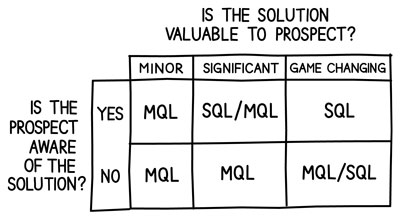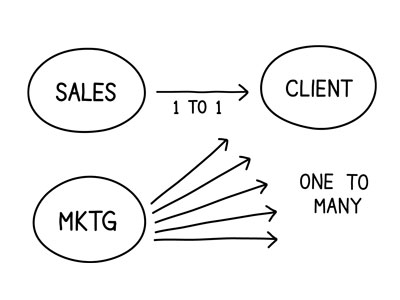Tactics for Managing Marketing and Sales Roles
Tactics for Managing Marketing and Sales Roles
We need to cover what to do with your sales and marketing staff. They are the experts in developing new business and naturally resistant to any encroachment into their turf. The day you walk in and announce that everyone sells, their eyes will roll. It’s natural. They are the professionals, no one can do what they do. In this section, we’re going to discuss how to smooth the transition from an organization with siloed sales staff to a company where everyone looks for opportunities. To start, we define marketing qualified leads (MQL) and sales qualified leads (SQL).
Leads are individuals or organizations that are in the market for, or have expressed an interest in your goods and services. We break leads down into two types, the MQL and SQL. The easiest way to understand the difference is using Figure 6.3.

Figure 6.3 Marketing qualified leads vs. sales qualified leads
It’s based on the answers to two questions. Is the individual or company aware of the problem you solve or the result you provide? And is your solution perceived as valuable to them? Their awareness we describe in simple terms, yes or no. Their perception of the value we use three grades ranging from minor, to significant, to game changing, which we interpret as “has to have it.”
The job of your marketing staff is to raise awareness of your products and services. They are actively moving individuals and companies to the upper right-hand areas of the grid. For instance, if the prospect isn’t aware of the problem, the marketer can work on increasing awareness. If the prospect is aware of the solution but sees the outcome as minor, the marketer can work on increasing the perceived value. Once the individual or company is aware of the problem and considers the solution to be a game changer, sales gets involved. The first step in getting your sales and mar- keting people on board with The Human Being’s Guide to Business Growth program is giving them this map and defining the sequence. Your regular staff doesn’t need to know difference between an MQL and an SQL, just that they need to help your company uncover some new opportunities. Your sales and marketing team needs to know that at best, your staff, vendors, and customers are going to increase the number of MQLs and move some prospects from no awareness to being aware. That’s all.
I was listening to bestselling author John Grisham’s agent, David Gernert, describe how they met and their first blockbuster book and movie deal. In describing the process behind where a best-selling book comes from, Gernert says that it isn’t the blockbuster deals and new unsigned authors that end up at the top of the sales charts. It’s more likely the third- or fourth-time author who gets their agent, their editor, the publishing staff, the book representatives, the independent booksellers, the big book- sellers, and the author’s audience all working together to create a buzz. As he said, the best-sellers just seem to find their own way. That’s a great way to describe to your sales team what changes they can expect to see in how they do their work. In time, they should see an increased awareness of your company in the marketplace. More MQLs.
Your marketers, on the other hand, may not appreciate Gernert’s story. Their job, after all, is to produce more MQLs. If you’re asking your entire staff to help with the effort in securing more MQLs, they must not be doing their jobs, right? Part of being human is not wanting to let anyone down, so your first job is to let them know they haven’t done anything wrong. Your second job is to ask for their help with branding, language, and follow up. Here are three areas where your marketers add the most value to the process
- Branding – We define branding as the consistent representation of your company’s service promise. When you see McDonald’s golden arches, you know what to expect in terms of service and product, regardless of where you are in the world. When we traveled to China, after four days of native cuisine, my boys made a beeline straight to the McDonald’s counter for some fries. They knew what to expect and were not disappointed. Your branding should accomplish the same outcome and your marketing team is responsible for provid- ing that consistency. However, we don’t advocate that they become the brand police, judge, and jury. Teach them a simple process for dealing with brand issues such as: the first brand infringement is no one’s fault, the second one is marketing’s fault for not being clear on how to fix the first infringement, and the third is a real problem and needs to be escalated.
- Language – Marketers love communicating. Some lean toward visuals, but many consider their strength to be persuading with the written word. That makes language the perfect place for your market- ing talent to help the entire company. They are naturally persuasive communicators. Encourage them to go through the list of tactics at the start of this chapter and brainstorm how they can help commu- nicate in each instance. What should the networker say? How much information is too much information about what you do? What’s the best way to ask for permission to stay in touch? Those are all areas where marketing can get on board to help develop more MQLs.
- Follow up – Follow up is where marketing shines. A good marketer wants to know of everyone who has heard of the company. As a matter of fact, the difference between sales and marketing can be summed up as marketing is one-to-many persuasive communication, and sales is one-to-one persuasive communication, see Figure 6.4.

Figure 6.4 Marketing is one-to-many, sales is one-to-one
That one-to-many communication is how most new leads from the company should be followed up on. Most MQLs will be barely aware of the products and services you offer or how they apply to problems or results the prospect is dealing with. They aren’t ready for sales to persuade, so your marketing staff’s follow up is preferred. Here’s a short list of follow-up vehicles marketing can help with:
(a) Email introductions to key personnel
(b) Brochures mailed
(c) Relevant case studies
(d) LinkedIn and other social media connections
(e) Articles of note
(f ) Upcoming events where your company is exhibiting (g) Invitations to subscribe to newsletters or periodicals
Take social media for instance, letter (d) above. Your controller has volunteered to help the company by taking a leadership position in her favorite charity. She becomes the treasurer and is recognized for the effort at your monthly all-hands-on-deck meeting. The marketing staff recognizes this as an opportunity and offers to help her connect with the board members on LinkedIn. They readily connect with her, and your team can now have her re-post company articles and blog posts to her network, raising the awareness of your company and solutions.
It doesn’t take much more than that, but it does take consistency. Help your marketing staff see that everyone raising awareness, combined with their skill sets, will increase the odds that your prospects discover the value your company offers.
(from The Human Being’s Guide to Business Growth, by Gregory Chambers)
